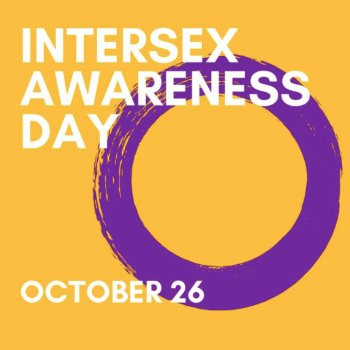Celebrate the Spectrum

Sex is a spectrum. We're used to our Biology classes over simplifying sex into two categories of female or male.
By Daisy Wang (she/her/hers), 2021 Undergraduate HERlab Intern, CHA.
Babies don't always fall into this binary with 1.7 to 4 percent of babies being neither female nor male. Chromosomes, gonads, internal or external genitalia in these children—intersex children—differ from social expectations.
Historically, when children with atypical sex characteristics were born in the United States, their doctors and parents made their best guess and assigned the child a sex. The parents then raised them per social gender norms. Medical norms in the 1960's changed dramatically as doctors began recommending surgical solutions to the "problem." Intersex surgeries were rooted in heteronormative and patriarchical perspectives about sex, gender, and marriage.
In many cases, surgery resulted in stigmatization, confusion, and fear. Doctors often advised parents to conceal the diagnosis and treatment from the child, instilling feelings of shame in both parents and children. As a result, many intersex people did not learn about their conditions until they saw their medical files as adults. Isolated, they stayed quiet, believing no one else shared their experience.
In 1993, feminist biologist Anne Fausto-Sterling published articles in The Sciences and The New York Times exposing the spectrum of sex and affirming the existence of intersex. Cheryl Chase founded the Intersex Society of North America (ISNA) shortly thereafter. Her sex-reassignment in infancy led to medically-induced shame, reinforced by the disinterest of most of her former care providers. ISNA continues to advocate for reform, raising ethical questions around lack of information and informed consent. Intersex people are more likely than the general population to report unfavorable experiences of accessing healthcare, including poor communication from health professionals and dissatisfaction with the treament and care received.
Today, intersex children and their families often consult a team of specialists -- not just a surgeon. These Difference of Sex Development (DSD) teams convene multiple healthcare specialists, including mental health providers, to advise and treat intersex patients. Disclosure of a child's intersex traits to the child is recommended and cosmetic surgeries are considered problematic. Further advocacy argues for non-normative formulations of human sex.
Kristina Turner from Washington state gave birth to her intersex child in 2007 and protected her child from surgery. "You can't undo surgery," Turner said. She and her husband decided to raise Ori as a girl, following advice from practitioners. Ori was raised understanding children can decide their own sex. At the age of 7, she came to Turner and said "I feel like I was supposed to be a boy." In 2017, Ori asked to be called by gender neutral they/them pronouns. The Turners stand by their decision to refuse surgery: "Raising Ori is just like raising any other kid."